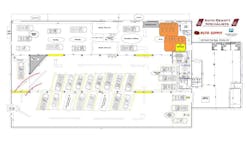It’s impossible to consume any media these days without navigating a myriad of shoehorned-in Taylor Swift references, but please excuse one more: When it comes to laying out a collision repair shop, there’s no better starting point than a “blank space.”
But blank spaces have a way of filling up swiftly (sorry). It may seem like that wide-open 20,000-square-foot floor will fit everything your shop needs and then some. But once you start placing equipment, it can be easy to forget things, and suddenly, that wide-open floor isn’t so open.
“A lot of times, initial layouts and drawings are done, and the idea for workflow doesn't necessarily match how they actually do it with their particular people and skill sets,” says Lance Getz, co-owner of Quincy Auto Supply, a PPG Platinum Distributor and auto parts store in Quincy, Illinois, and who was a PPG territory manager and later business development manager from 2004 to 2017. “… So how you do it and how you lay it out also really is impacted by what your team of people looks like, and your skill sets, and your ability to hire people for that.”
How you choose to physically lay out a shop is important, but so, too, is the process that moves cars through that layout.
People and process
Shops build new spaces or renovate existing ones for a reason. Something about the old space wasn’t working. And if the space wasn’t working, it’s also the perfect opportunity to look at all aspects of how you do business.
“Sometimes, when moving to a new shop, it's a good time to change the ‘how we do it here,’” says Getz. “Because there's lots of ways to do it.”
A shop’s layout and its repair process go hand in hand, says John Shoemaker, business development manager for BASF.
“If you don't disassemble vehicles right, create a strong repair plan at the beginning, your layout, your floor plan, production processes aren't going to matter,” he says. “Because those cars could be going back and forth.”
Shoemaker says that one of the trends in shop design is having more spaces dedicated to certain tasks. With cars having more specialized repair needs these days, it can be more efficient to have a dedicated space with a corresponding, specially trained, technician. One example is disassembly, where Shoemaker has seen shops appoint a specific teardown technician and a damage appraiser working in that station all day. When Shoemaker sets up a shop, he pushes for a blueprinting space with a two-post lift and measuring system, and from there if the car needs alignment it can go to Structural, then from Structural to Body, if need be, or to Reassembly. Cars are always moving forward in the process, not back and forth.
“It’s a definite, absolute culture change to move like that, because they’re so used to walking out and handing somebody a repair order and say, ‘Fix the car,’ Shoemaker says. “And we just can't do that anymore. There’s too many specific systems on cars. And somebody needs to be trained on the structural aspects of the vehicle to complete those repairs.”
Planning for movement
A common shop layout, and one that Shoemaker favors, is the “racetrack” style, in which cars move on a loop within and ultimately out of a shop at the end of the process. But not all shops have an easy-in, easy-out path in and out of the building. Shoemaker cited an example of a shop that was mandated to have a retention pond and could only bring in cars one way. That shop ended up using a J-shaped layout in which cars go in and eventually double back to go out.
Getz recalls a shop that had plenty of space, but many support columns that made it difficult to make any 90-degree turns with cars. So, the solution was to have angled stalls along an inside lane to the left. The cars then took up the space normally blocked by the columns, leaving a clear lane for movement.
As with the aforementioned retention pond, unexpected things come up when building a shop. Some creativity might be required. If the available square footage is a concern, Shoemaker has seen shops opt to build upward.
Adding a mezzanine, say for the ever-increasing need for parts storage, can be a more cost-effective option than you might expect, says Shoemaker. It wouldn’t even require a freight elevator; Shoemaker has seen shops install a conventional wheelchair elevator. They’re big enough to fit a parts cart, can move 500-600 pounds, and require a lot less of an investment and engineering to install.
“You can put the employee break room, and maybe the tool room up on a mezzanine,” says Shoemaker. “Then you would have all this additional square footage … and still keep all your body work functions down on the main floor.”
Remember the essentials
Unless there is unlimited time, space, and money, compromises must be made in any building project. That’s why it’s vital to know your shop’s need-to-haves and how they fit in. There are some things that can’t easily be moved later -- think electricity and air hookups.
“Really get down to, OK, where are we going to have a water spigot? Where are we going to have this electrical outlet, for 220, for the resistance spot welder,” says Getz. “And when the car leaves here, how do we make sure we don't have a car in its way?”
Any kind of hose or cord on the ground blocks a path for a parts cart to get through. So, Getz advises to consider getting those sorts of things off the ground if possible. That’s the sort of improvement that can only be easily made when building out a new space.
It is perhaps easy to focus on the big picture with shop design: making space for cars and planning how they move across the floor. But there are all sorts of things that also need space in a shop, and not just heavy equipment. It may seem simple, but even the location of a trash can should be considered, just like anything else employees are going to need regular access to.
“Knowing where we are going to have that, so if it's something we use every day it needs to be within that side of the shop or within the shop,” says Getz. “If it's something we use once every week, it needs to be stored maybe in a tool storage area. That's not too hard to get that machine or a piece of equipment to the car. And then if it's something we only use monthly, maybe we put it into an exterior storage shed or storage container or something so we can get to it.”
Above all, a shop’s space needs to be used in the most efficient manner possible. That starts with a good process, executed by well-trained technicians.
“When you have everything you need to fix that vehicle, that comes into the shop one time and it leaves,” Shoemaker says. “And that's what maximizes your space; the more you move cars in and out, it just doesn't matter how well you've defined your space, because people are going to misuse that space.”
About the Author
Todd Kortemeier
Todd Kortemeier is former editor of FenderBender magazine and started writing as a contributor in 2024.

